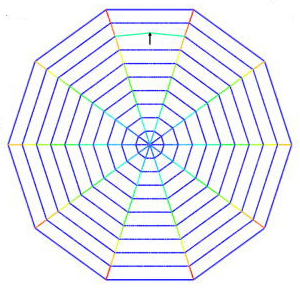 the stiffness
and strength of the web remains the same throughout,
regardless of how far the force impacts from the center of
the web. It has also been found that the
adhesive dotted capture thread behaves much like an elastic
solid whenever it is stretched. However when it is compressed
the adhesive along the web cause the solid silk to spool like a
liquid. Even being compressed to 95%, the web remains under the
same tension. With the combination of how the spider web is kept
under tension and the adhesive silk, spider webs are able to
trap insects (rather than them bouncing straight off or
destroying the web on impact).
the stiffness
and strength of the web remains the same throughout,
regardless of how far the force impacts from the center of
the web. It has also been found that the
adhesive dotted capture thread behaves much like an elastic
solid whenever it is stretched. However when it is compressed
the adhesive along the web cause the solid silk to spool like a
liquid. Even being compressed to 95%, the web remains under the
same tension. With the combination of how the spider web is kept
under tension and the adhesive silk, spider webs are able to
trap insects (rather than them bouncing straight off or
destroying the web on impact). There
is also species of spider that relies on electrically
charged webs; orb spiders named Uloborus plumipes.
Uloborids are named as cribellate spiders, meaning that
they produce wool-like, charged silk rather than the
adhesive capture silk that spiders typically spin. The
silk is made within the cribellar gland, at a size of 60
micrometers it is among the smallest silk glands ever
observed and is covered in microscopic spigots that
produce a low-viscosity liquid silk (sciencemag.) Other
spiders spin web that is intact from the start however,
Uloborus spiders produce silk that is still liquid when it
surfaces. This dry capture thread combines thousands of
nano-scale filaments to be quickly hackled by feather-like
hairs on the spider's legs and electrically charged in the
process. This is all possible because Uloborus spiders
have one of the most complex silk glands known as of yet,
consisting of six different silk systems.
In conclusion, the hackling applied to the web stretches and freezes the fibers into shape, and is likely responsible for strengthening them as nano-scale filaments are strengthened after being stretched (sciencemag.) To charge the silk, the spider pulls it over the feathered hairs on its hind legs (which will also give the web a wool-like appearance.) The electrically charged silk will theoretically attract prey to the web as any charged object will attract another object that is oppositely charged.
In conclusion, the hackling applied to the web stretches and freezes the fibers into shape, and is likely responsible for strengthening them as nano-scale filaments are strengthened after being stretched (sciencemag.) To charge the silk, the spider pulls it over the feathered hairs on its hind legs (which will also give the web a wool-like appearance.) The electrically charged silk will theoretically attract prey to the web as any charged object will attract another object that is oppositely charged.